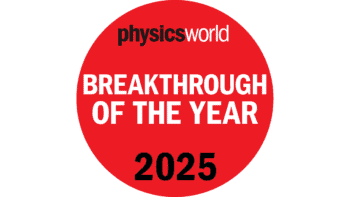An electrical method has been used to transfer ‘spin’ between electrons and nuclei in a semiconductor for the first time. Jurgen Smet of the Max-Planck Institute for Solid State Research in Germany and co-workers devised the technique, which is a step towards the storage of information in the quantum states of particles. The effect could also lead to a new tool to probe the interactions between the spins of electrons and nuclei (J Smet et al 2002 Nature 415 281).
Particles with spin angular momentum – a quantum mechanical property – behave like tiny bar magnets and can be aligned by a magnetic field. The operation of conventional electronic devices such as transistors depends solely on the charge of electrons, but physicists believe that highly efficient ‘spintronic‘ systems could be developed that exploit the spin of particles such as electrons and nuclei.
Now Smet and colleagues have brought these devices a step closer with the discovery that the spins of nuclei in a gallium arsenide semiconductor can be controlled with a gate voltage. As in a conventional transistor, the gate voltage controls the flow of electrons through the semiconductor. The team then aligned the spins of these electrons with a strong magnetic field and cooled the set-up to a temperature of 20 millikelvin.
By adjusting the magnetic field and the gate voltage, Smet and colleagues found that they could transfer spin from the electrons to the nuclei within the semiconductor. Moreover, the changes in the spins of the nuclei were reversible and reproducible, which suggests that they could be used to store information.
According to the German team, this phenomenon is also a novel probe of the interactions between the spins of electrons and nuclei. Under the conditions of the experiment, it takes much more energy to flip the spin of an electron than the spin of a nucleus. But if a particular number of electrons are present – determined by the gate voltage – the electrons cooperate to flip the spins of the nuclei using less energy than an individual electron would need. To conserve momentum, this effect has a ‘back action’ on the electrons, altering the current. This means that the state of the nuclear spins can be gauged by measuring the resistance of the semiconductor.
‘In a nutshell, we have developed a purely electrical method of measuring the interaction strength between electrons and nuclei’, Smet told PhysicsWeb. ‘This better understanding is a prerequisite for developing new ways of manipulating nuclear spins with the help of mobile electrons in nuclei’.
The idea that information stored as quantum states could be used to build a super-efficient quantum computer is extremely ambitious, and Smet emphasizes that it may be several decades before we know whether it is even possible. But in developing a probe for electron-nucleus spin interactions, his team has laid some of the foundations.



